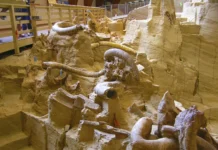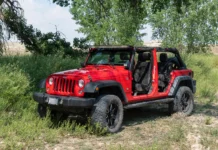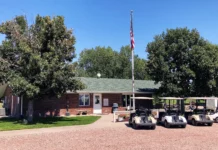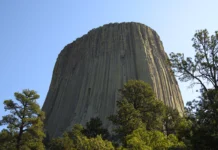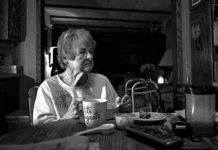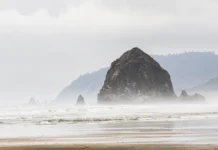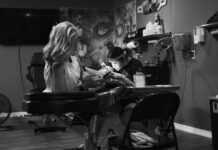| NEBRASKA |
People disappear all the time. Ask any policeman. Better yet, ask a journalist. Disappearances are bread and butter to journalists. Young girls run away from home. Young children stray from their parents and are never seen again. Housewives reach the end of their rope and take the grocery money and a taxi to the station. International financiers change their names and vanish into the smoke of imported cigars. Many of the lost will be found, eventually dead or alive. Disappearances, after all, have explanations. Usually. ~ Diana Gabaldon “Prologue”.
| THE JEWEL OF WESTERN NEBRASKA
From 1913 to 1917, the price of wheat soared from $.78 a bushel to $2.12, which in today’s money would be $50.95 a bushel, an astronomical price (the current price of wheat is $9.66 per bushel as of this writing). The United States government encouraged farmers to ‘Win The War With Wheat’, and Frank H. Cunningham set out to do precisely that while also “making a nice profit on the side,” as he would write in his memoirs. By the end of WWI in November 1918, Cunningham had made over $100,000 growing wheat on his Kimball county farm, the equivalent of over $2,000,000 today, and had spent nearly every dime of it making his dream come true, the Wheat Growers Hotel, which he called “the Jewel of Western Nebraska.”

The Wheat Growers consisted of eighty-six rooms, each with electricity, plumbing, and steam heat, which used a unique system designed by Cunningham which concentrated on heating the exterior rooms of the building so that even the iciest grip of a Nebraska winter could not penetrate the unheated interior rooms. Light and air to these inside rooms were provided by four ventilator shafts, another unique architectural feature. The tile floor of the foyer was inlaid with a shock of wheat, and a massive mural of wheat being harvested was painted in the lobby. The furnishings, ordered in March of 1918 from the Denver Dry Goods Company, cost Cunningham an estimated $15,000 ($305,258 in 2022).
By March of 1919, the hotel was hosting events, including banquets given by the local Patriotic League and the Kimball Freemasons lodge, which included entertainment provided by an orchestra. Two honored guests at the Masonic banquet were Gilbert Oldaker and Ray Lathrop, who had served on the front lines of the war in Europe as truck drivers. Future president Dwight D. Eisenhower and his family were even once guests at the hotel, and the Wheat Growers Hotel was soon the place to see and be seen in western Nebraska.
However, Cunningham’s financial empire was in ruins within a few short years. In 1920, the expiration of the Wheat Price Guarantee Act sent the price of wheat plummeting to a low of 50 cents a bushel. Farmers across the United States went bankrupt overnight, including Frank Cunningham. The Denver Dry Goods Company soon repossessed all of the furniture inside the hotel, the State Savings and Loan Company of Beatrice, Nebraska, foreclosed on the building itself, and Frank Cunningham was arrested in 1923 for purchasing coal to heat the hotel under false pretenses. By 1924, Cunningham’s dreams of grandeur were nothing more than the dust floating through the empty rooms of a boarded-up and abandoned hotel.
Eventually, the hotel reopened under new ownership but never regained its former glory. After passing through the hands of several owners over the decades, the Wheat Growers closed its doors for good in 1988, and the building’s condition quickly began to deteriorate.
| REPORTED SPECTERS
Rumors that the building was haunted soon led to break-ins and vandalism. One popular ghost story claims that, during Prohibition, a tunnel was dug under the hotel, allowing bootleggers to smuggle alcohol into the building. The story goes that the tunnel collapsed on a hotel employee, trapping her in the rubble, and killed. Her spirit supposedly haunts the Wheat Growers and has been seen from windows on the upper floors, looking out at the street below.
While the hotel may actually have its very own White Lady, as countless numbers of Kimball residents and visitors have claimed to have sighted her over the years, the rumors of tunnels underneath the building have been thoroughly debunked, and so who she was in life will forever remain a mystery.
The true mystery of the Wheat Growers is the disappearance of 31-year-old Robert “Shorty” Wilson.
By the 1950s, the hotel rooms were being rented as long-term apartments, and Wilson was a resident, the hotel being affordable and a five-minute walk from his job at Dalton Buick, located at 305 East 3rd St.
October 30th, 1956, started as a beautiful fall day in Nebraska, with a high of 61F, clear skies, and a steady breeze of about 15mph. Yet, for reasons that no one may ever understand, Robert, called Bob by his family and nicknamed Shorty due to his stocky, 4’8” frame, chose to take a cab on his errands.
At 3 pm, Mrs. T. L. James of James Taxi Service dropped Wilson off at Ray’s Sinclair Service Station at 315 East 3rd St., right next door to Dalton Buick. They arranged for her to return and pick him up from the service station in 30 minutes, but when Mrs. James returned in her cab, Robert Wilson was nowhere to be found.
Panic began to mount among his family members as the hours passed by with no sightings of Wilson. James Dalton reported that none of his dealership’s cars were missing and that checks collected on Dalton Buick’s account were found inside a car that Wilson had been using. He was not believed to be carrying much. if any, money on his person at the time of his disappearance, and his checking account at the bank in Kimball remained untouched.
Volunteers, headed by the Kimball Volunteer Fire Department, scoured Kimball and the surrounding area for miles. Gilbert Nelson and Don Brown flew over Kimball and Banner counties on Tuesday, November 12th, but their efforts proved futile, and no trace of the man was found.
The question of how Robert Wilson vanished is as much a mystery as why. He apparently did not drive a vehicle away, and he didn’t board a bus or train. If the pocket-sized car salesman had been assaulted or kidnapped in broad daylight, no signs of a struggle were ever found, and no witnesses ever stepped forward.
Bringing the search to a complete standstill was a horrific blizzard that slammed the Kimball area without warning on November 2nd, 1956, three days after Wilson went missing. In what was called the worst blizzard to strike western Nebraska since the hellish storm of 1949, the temperature plummeted to 27F, and 40 mph winds created drifts nearly as high as the marquee on the front of the Kimball Clothing Co. store on Chestnut Street.
Among the many dramatic rescues from the whiteout were two women who were stranded in a car on Highway 29 for more than 38 hours before being rescued by an airplane and another stranded motorist who was rescued by a highway department snow plow after his car went off the road between Dix and Kimball, only to have the snow plow itself slide off into the ditch, stranding both men until they were subsequently rescued by an R.E.A. (Rural Electrification Administration) truck and taken to safety in Kimball.
Livestock losses were staggering, and emergency food drops had to be made to drilling crews stranded on oil rigs as far away as Redington. In Bushnell, 20 men armed with shovels and one man in a bulldozer battled drifts for seven hours to clear 9 miles of rural roads and rescue a child who was suffering from a skull fracture on a farm southeast of town.
On November 15, 1956, after Wilson had been missing without a trace for more than two weeks, the Western Nebraska Observer reported that Robert’s twin brother, Dick, was offering a $500 reward ($5200 in today’s money) for information leading to the recovery of either Robert or his body.
Dick Wilson said, “There just isn’t any concrete motive on which we can put our finger. I do not believe that Bob left of his own account. Money was certainly not involved. Besides, there is the fact that he is the type that no one could use enough money to pay him to cause this much concern on the part of his family.”
Dick Wilson canceled the reward on Dec 27th after receiving no information about his brother’s whereabouts other than a reported sighting on the streets of Denver, Colorado, which the Denver police investigated and disproved.
In August of 1957, 9 months after Robert’s disappearance, Wilson’s family again offered a reward for information about his whereabouts, increasing the amount to $1000. Once again, his anguished family received nothing. Dick Wilson died in 2012 at the age of 87, having never resolved the mystery of his twin brother’s disappearance.
Today, the only earthly remnant of Robert Wilson is a headstone in the Kimball cemetery, which reads, “Robert G. Wilson, born May 28th, 1925, disappeared October 30th, 1956.” However, Robert Wilson is still roaming the halls inside the once majestic Wheat Growers Hotel. How a 4’8” tall man, well known as far away as Sidney and Scottsbluff, managed to enter and leave Ray’s Sinclair Service Station, make the ¼ mile trek on a busy street in broad daylight back to the Wheat Growers, and then enter an occupied 86 room hotel without ever once being seen, and what happened to him once he got there, if he ever actually left the service station at all, are mysteries that may never be solved in this lifetime. After an extensive investigation, an archaeological team concluded that Wilson’s body actually lies at the bottom of a “rat hole” (a hole in a drilling rig floor, 30 to 35 feet deep and lined with casing pipe) on a oil rig site outside of Kimball.
On a recent tour of the Wheat Growers, accompanied by several members of the Kimball police department and the hotel’s owner, Ed Avila, our normally fearless photojournalist documented an anomaly that reduced any urge ever to make a return visit to the Jewel of Western Nebraska. Hawk was documenting the room Robert Wilson had once called home for this story when something unexplained occurred, persuading him to beat a hasty retreat in the opposite direction of whatever had just crossed his path. Apparently, murderers and terrorists are less frightening than the restless spirit of a Lilliputian car salesman if that is the true nature of these sightings. If the mysterious disappearance of Robert Wilson is ever going to be solved, it looks like we’ll have to bring in some slightly less chicken-hearted ghost hunters next time. I happen to know a 5’, 100 lb girl living in Lyman who has some free time.
| AN ODD OCCURRENCE
Someone needed to drive to Kimball, Nebraska, to get images of The Wheat Growers Hotel for this story we had been planning since July of 2022. That person was me, Hawk Buckman.
I set out on this adventure with limited time, not knowing anything about the location or the history of the Hotel. I had been told that the Hotel was haunted; that the Kimball Police had been called to the Hotel by neighbors living near it on the report of lights and period music playing several times loudly. That’s all I knew.
When I arrived in Kimball, I made a left off old highway 71, just after the railroad bridge, and drove two blocks east to look for the hotel. I found it and parked my truck across the street from the front of the building. I shoot with film cameras which I find more challenging and, in my opinion, provide better aesthetics than digital cameras, which I loathe entirely. I grabbed my girlfriend’s medium format camera, loaded it with Kodak Portra 400, set the ISO at 320, and made a few images of the exterior of the building from the public roadway.
I walked up to the large glass windows of the Hotel and looked inside, where I saw evidence of remodeling. The walls were torn out, and studs lined what looked like a hallway where the light shone through a boarded window that illuminated the back of the building. Caution tape was stretched across the hall, warning workers to beware or avoid that area.
I raised the camera and pressed the lens hood all the way up against the glass to reduce glare from the glass panes.
Being absent-minded gets you either in or out of trouble sometimes. This particular time I made the mistake of putting the camera on continuous mode, which means that the camera will make an image and advance the film to the next frame as long as the shutter release button is held down. I made two images rather than the single image I was hoping for. But that is where this story gets interesting.
While holding the camera to the glass and looking through the viewfinder, trying to get the best composition, I heard a car coming down the side road. As it drew near, I saw through the rangefinder that a shadow had been cast right in the middle of the frame, slightly to the right of the view field near the wall. The shadow crossed from the right to left as the car was driving by and was quickly gone. I noticed it, and thought nothing of it other than ‘that car just blew my shot..’.
Then the second frame advanced, and I accidentally made the second image. Quickly lifting my finger from the shutter release button and cursing out loud because I had been so stupid as to expend a frame of film, I adjusted the camera settings and walked back to my truck, still pissed that I had made such a rookie mistake by leaving the camera on continuous mode.
Remembering the report of loud music, the lights in the middle of the night, and the Police being dispatched to the Hotel, I wanted to find out the response time from the Police Department to the Hotel. I drove one and a half blocks and found the Station. Response time is about thirty seconds.
I drove around the front of the Police Department and saw two Officers sitting in their truck. I decided to introduce myself. I told them who I was, and why I was there and ask if they had any idea as to the validity of the rumors I had heard. A little shocked, both Officers told me yes and offered to contact the Chief of Police Andy Bremer who arrived about five minutes later.
Andy invited me into his office, where we sat and talked about the history of the Hotel. He then asked me to reach out to Ed Avila, owner of The Wheat Growers Hotel. To our surprise, his assistant, Miss Dakota, called Ed, who happened to be one door down at the bank, and he arrived at the Police Department about three minutes later.
Providence on our side, Ed went over the gossip and what he actually knew about the structure and its history (Listen to the audio above).
Then, he offered to take me to the Hotel and allow me to make some images of the inside of the building. To our surprise, the entire Police Department on duty accompanied us on a world-class investigation of The Wheat Growers Hotel, where we all explored the inner sanctuary looking for remnants of a Speakeasy, which we found, and the remains of a tunnel entrance, which we found none.
We left the basement area, went upstairs, and walked towards the room that Shorty Wilson had rented near the back wall of the building in the hallway. This is the scene (area) I had unwittingly made the image peering through the glass at the front of the building earlier.
Ed began telling us the story of Shorty Wilson, his life, and his disappearance when he noted that a shadow, and a glowing green light, had been seen many times in the building by visitors and volunteers, which he, and they, attributed to Shorty’s presence. I then mentioned that I had made two images, one by mistake as a car drove past the building and another deliberately before finding the Police department and meeting him. I continued to explain that a car was passing by at that moment and cast a shadow on the door at the end of the building. It was nothing. Just a shadow produced by the cars passing. That’s when Chief Bremer spoke up and said, “it couldn’t have been a car that made the shadow.” I ask, ‘why is that? It had to have been the car. I heard it coming, and it blew my shot.” He looked at me seriously and said, “Come here. Let me show you something.”

We walked from the back of the room to the southern wall. He said, “Look out the window.” I peered around the boards that blocked the window glass and, to my astonishment, saw that we were at least 10 feet off the ground, facing a small courtyard where a tree was growing. It was then that I realized that what I had seen couldn’t have been a passing car’s shadow unless it was at least 15 feet tall and driving down the ally, which it wasn’t.
Ed then asked me to show him where I had seen the shadow. We walked back to the hallway to the back of the building, and I said, pointing toward the area, “right about here.” “It was only a second that I saw it, and had I not been using a rangefinder camera, I wouldn’t have seen it at all.” (The viewfinder of a Rangefinder camera is separate from the lens. You look through a viewfinder on the left or right side of the camera. Rangefinders do not preview through the lens that makes the image.)

As I was standing in the hallway facing Ed and the rest, Ed said, “This is where people see the shadow most often. Shorty spent a great deal of time here in this spot.” Then Ed told me he lived in the Hotel and pointed towards torn-out walls that framed a small area directly behind me. ‘That was Shorty’s room,” he said. “He had a small cupboard on the room’s outer wall that he kept his belongings in.”
That is when I decided that I had had enough of this particular adventure into the history of WyoBraska. I thanked everyone for their hospitality and told Ed, and the Police Officers there that I would get the film developed and share the image with them if the camera caught the shadow I had seen.
About thirty minutes later, after chatting a little longer, our company dispersed.
Almost two months passed before I could get the film processed through my Lab in California. I had completely forgotten about it due to personal and family issues. When it did arrive, I didn’t look at the negatives or scans until I was preparing Kat’s (above) story and needed images to go with it. Surprisingly, I found the shadow anomaly right where it was supposed to be, in the negative and the print.
I’ve been a Photographer for a long time. I’ve witnessed many things through a camera lens over the years and have made thousands of images. None but two have ever forced me to consider the truth of photography. Of the two images I’ve called into question, one was made last year at the Fort Laramie Post Hospital that I shared with a few friends and decided never to publish under any circumstances. That camera was a Nikon F5 (film camera). The second was the image of the hallway and shadow anomaly, which I can’t explain, nor do I want to. The anomaly is on the film negative in one frame only. It does not appear in any other image on either of the two film rolls I shot that day.
| CREDITS & RESEARCH
Interviews with Kimball Police dept, Ed Avila, eyewitnesses, and news reports.
Story by: Kathrine Rupe
Photography by: Hawk Buckman









